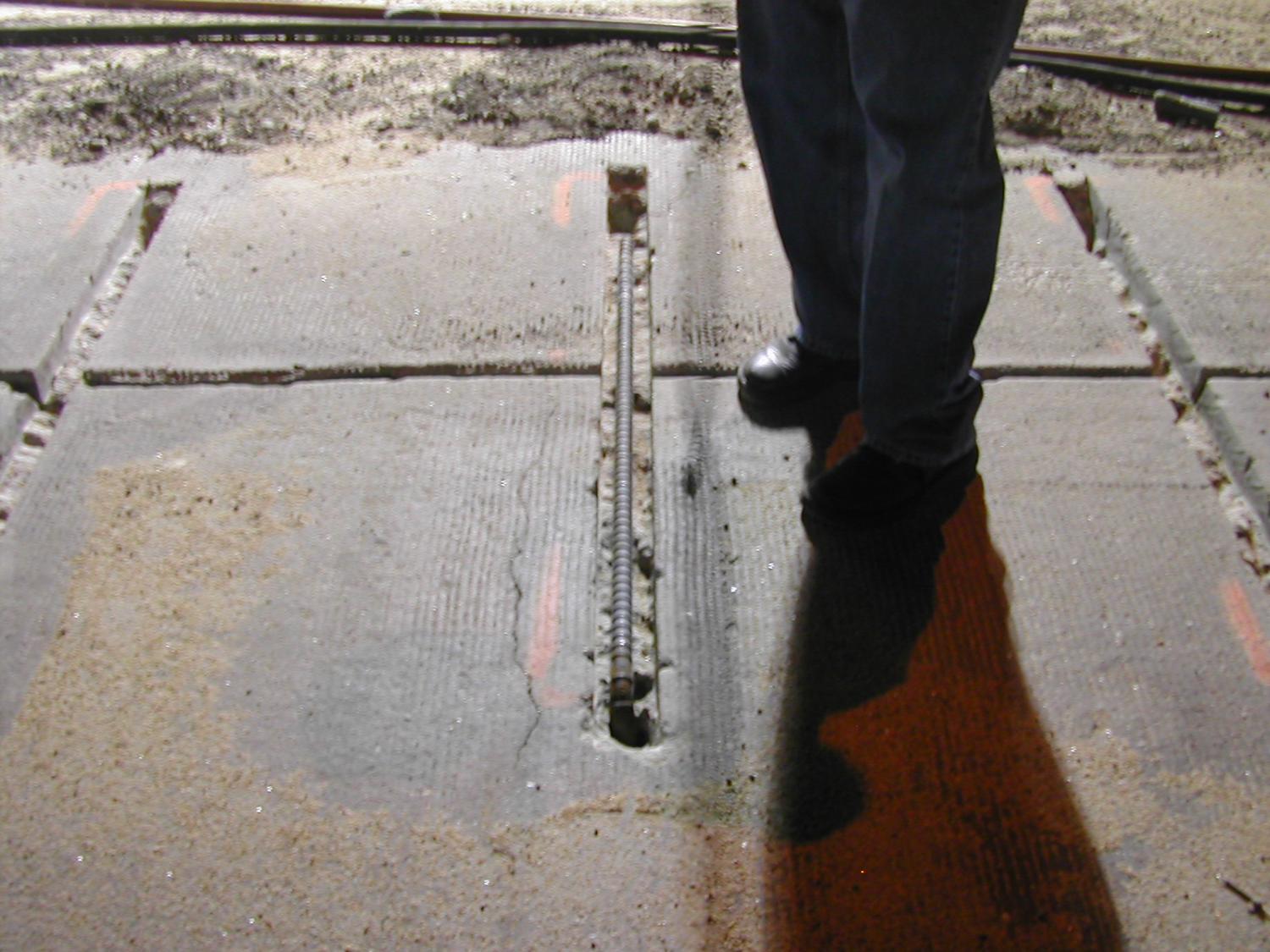Section 6: Stitching
Anchor: #i10111186.1 Introduction
Stitching is performed at longitudinal cracks to maintain aggregate interlock and provide additional reinforcement to minimize the relative movement of concrete slabs at the cracks. It is also used at the longitudinal joints to keep the slabs from separating.
Anchor: #i10056686.2 Pavement Distresses that Require Stitching
In CPCD, stitching should never be used at transverse cracks. Stitching transverse cracks in CPCD will cause stress buildup from the volume changes due to temperature variations somewhere else and result in additional cracks or spalls. Transverse cracks in CPCD section should be repaired with either FDR or dowel bar retrofit. Longitudinal cracks in CPCD do not necessarily deteriorate at the same rate as transverse cracks, so the slabs do not need to be removed and replaced. Longitudinal cracking in CPCD is most often caused by shallow and possible late saw-cutting of longitudinal contraction joints. For longitudinal cracks that are not continuing to widen, only sealing of the crack may be needed. For longitudinal cracks that are continuing to widen, stitching is a good repair option to keep the cracks tight. Longitudinal cracks should be repaired as soon as possible after identification to prevent further deterioration and separation. Repairing the cracks early saves money in the long term.
In CRCP, the only time stitching is utilized is where lanes are separating at the longitudinal construction joints. In CRCP, transverse and longitudinal reinforcements are provided and cracks are held tight and typically do not cause pavement distress. When longitudinal cracks extend through the full slab depth, punchouts will result and full-depth repair of the pavement is the most appropriate repair option.
CPCD and CRCP have reinforcing steel crossing the longitudinal construction and contraction joints which keep the lanes from separating. However, for various reasons, lanes do separate at longitudinal joints, primarily longitudinal construction joints. In some projects where bent tie bars were used, the tie bars were not straightened after the slip-form paving machine passed. In other projects, corrosion of the tie bars was noted. Corrosion and shear were found in association with tie bar failures and lane separations. These construction errors and steel deterioration resulted in lane separation. Lane separations over 2 in. wide have been observed. The negative effect of lane separation is that, in addition to the safety hazard to motorcycles, load transfer to the next lane is not achieved, and the slab will be subject to edge loading rather than interior loading conditions. Edge loading conditions cause higher wheel load stresses than interior loading conditions do, and increases the potential for longitudinal and/or corner cracks in CPCD and punchouts in CRCP, which reduces the pavement life.
There are other possible causes for lane separations, such as weak base layers. In Project 0-5444, there was no direct correlation found between DCP readings and the likelihood of longitudinal cracking or lane separations, but when lower modulus values of base were found, the possibility of problems with longitudinal cracking and joint separations was greater.
If voids are present under faulted slabs, the pavement should be undersealed to re-establish uniform support for the slabs prior to performing stitching operations.
Falling weight deflection testing is often used to measure load transfer efficiency (LTE) to determine is stitching is warranted. When taking load transfer efficiency (LTE) readings, the deflections associated with the LTE test locations need to be known to determine the condition of the pavement. A high or low LTE reading can be misleading; a high LTE reading does not necessarily mean the pavement is in good condition. However, high measured deflections always means the slabs have low LTE.Stitching has been rarely used by the department. However, lane separations have occurred at the longitudinal joints and, lately, stitching has been used on several projects. When considering the use of stitching, contact MNT – Pavement Asset Management for assistance.
Anchor: #i10057056.3 Types of Stitching
There are three types of stitching methods: cross-stitching, slot-stitching, and U-bar stitching. Cross-stitching is the most widely used method. Project 0-5444 investigated lane separations and the best repair methods.
Cross-stitching should be used to repair cracks/separations that are fairly tight. In cross-stitching, holes are drilled at an angle so that they intersect the longitudinal cracks or joints at about mid-depth of the slab. Dust is removed by compressed air, and epoxy is injected into the holes. Tie bars are inserted, and excess epoxy is removed.
For wider cracks/lane separations, slot-stitching should be used. Slot-stitching is the most economical repair method for restoring load transfer, preventing separations, and improving performance of longitudinal joints and wide cracks. In slot-stitching, slots with lengths no shorter than 25 in. are cut approximately perpendicular to the longitudinal joints or cracks using a slot cutting machine or walk-behind saw. Slots are prepared by removing the concrete and cleaning the slot. Deformed bars are placed and a repair mortar is applied, finished, and cured. In slot-stitching, the concrete slabs are held together by the shear stress of deformed bars. It is important to provide high strength repair mortar with good bond and to have good consolidation around the bars.
In U-bar stitching, slots are cut using a slot-cutting machine, and concrete is broken and removed by pneumatic hammer. Figure 10-16 shows the slots and U-bars. In this method, anchoring action by the U-bars provides most of the restraining force. Use of proper repair materials and consolidating around the ends of the U-bars is important.
Figure 10-16. Slots and U-bars.
Project 0-5444 investigated what causes lane separations and the best repair methods. The following conclusions regarding longitudinal cracking and joint separations in concrete pavements have been made upon completion of the research project.
